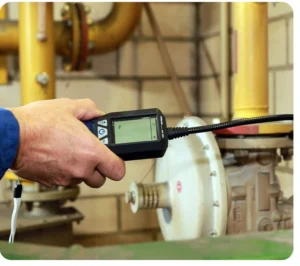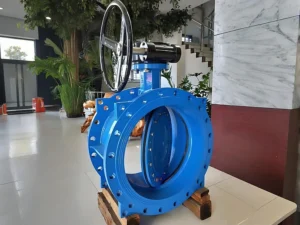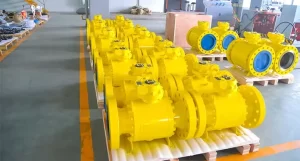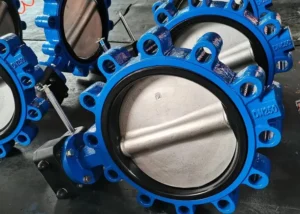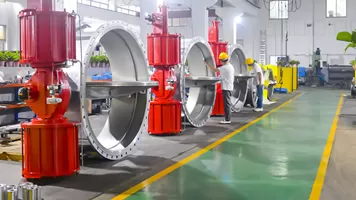Check valve definition and function
A check valve, also known as a non-return valve or one-way valve, is a device that allows fluid (liquid or gas) to flow in only one direction. This essential component is used in various systems to prevent backflow, which could cause contamination, damage, or other operational issues.
Check valves are widely employed in industries such as plumbing, water treatment, chemical processing, and power generation. They are commonly found in applications like pumps, compressors, and pipelines, where unidirectional flow is critical for efficiency and safety.
The basic design of a check valve includes a valve body, a movable disc or ball, and a spring mechanism. When fluid flows in the intended direction, the force of the flow pushes the disc or ball away from the seat, allowing the fluid to pass. When the flow stops or reverses, the spring pushes the disc or ball back against the seat, sealing the valve and preventing reverse flow.
Key benefits of check valves include their simple design, automatic operation, and ability to maintain system integrity by preventing reverse flow. They are available in various materials and sizes to suit different applications and fluid types. Selecting the appropriate check valve for a specific application involves considering factors like pressure, temperature, flow rate, and the type of fluid being handled.
How check valve works
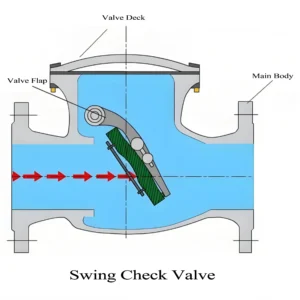
A check valve, also known as a non-return valve, allows fluid to flow in one direction and prevents backflow. It consists of a valve body, valve disc (or piston), seat, and spring. When fluid flows in the desired direction, the pressure pushes the valve disc away from the seat, allowing fluid to pass through. The spring provides a counteracting force, keeping the valve disc in place when the forward flow ceases. In the event of reverse flow, the fluid pressure pushes the valve disc against the seat, closing the valve and preventing backflow. The spring ensures a tight seal by pushing the disc firmly against the seat, while the design of the disc and seat ensures minimal leakage. This mechanism ensures that fluid flows only in the intended direction, protecting the system from potential damage caused by reverse flow.
Detailed Introduction to Types of Check Valves
Check valves are essential components in many industrial applications, ensuring unidirectional flow and preventing backflow. Here are detailed descriptions of several key types
1. Swing Check Valve

The swing check valve is the most commonly used type. It operates with a disc that swings on a hinge or a shaft. When inlet pressure increases, the disc swings off the valve seat, allowing fluid to flow through the valve. As inlet pressure decreases or there is backflow, the disc swings back to the seat to restrict fluid flow.
This check valve offers minimal resistance to flow when open. If springs are not used to assist the valve in closing, the valve should be mounted to allow the disc to shut by gravity.
Forged Steel Check Valve
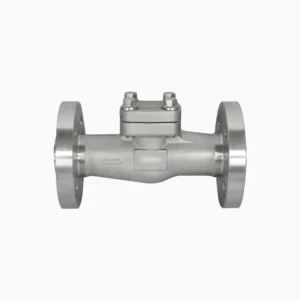
A Forged Steel Check Valve is a type of valve designed to allow fluid to flow in one direction while preventing backflow. It is constructed from high-strength forged steel, making it durable and suitable for high-pressure and high-temperature applications. These valves typically feature a robust, compact design and are used in various industries such as oil and gas, petrochemical, and power generation. They operate automatically, using the pressure of the fluid flow to open and close the valve disc, ensuring a unidirectional flow. Their construction and material provide excellent resistance to wear, corrosion, and pressure, ensuring long-term reliability and safety in demanding environments.
Dual-Plate Check Valves
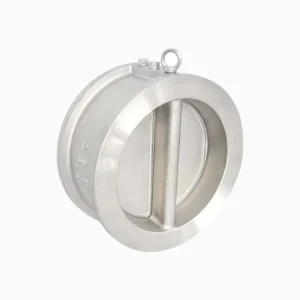
Dual-Plate Check Valves, also known as dual-disc or split-disc check valves, are designed to prevent backflow while allowing fluid to flow in one direction. These valves feature two spring-loaded plates that open when fluid flows in the forward direction and close to prevent reverse flow when the fluid reverses. The dual-plate design offers several advantages, including reduced water hammer, lower pressure drop, and compact size. These valves are commonly used in applications such as water supply systems, HVAC, power generation, and industrial processes. They are typically made from durable materials like stainless steel, carbon steel, or other alloys, ensuring longevity and reliability in various operating conditions.
Check valve application scenarios
Check valves are widely used across various industries due to their essential function of preventing backflow and protecting piping systems and equipment. Below is a discussion of check valve applications in different industries and the reasons for choosing specific types of check valves in particular scenarios:
Applications in Different Industries
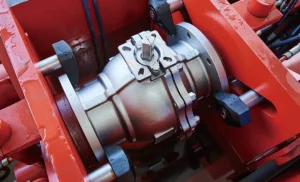
- Oil and Gas Industry: In the oil and gas sector, check valves are critical in preventing backflow during extraction, transportation, and processing. For instance, in oil field pumping systems, check valves are used to prevent oil and gas from flowing back into the wellbore, thereby protecting the pumping equipment and ensuring efficient operation.
- Chemical Industry: The chemical industry involves handling various chemical media and complex reaction systems. Check valves are crucial in preventing backflow of chemical substances, thereby avoiding hazardous situations during chemical reactions. For example, in acid and alkali transfer pipelines, check valves prevent corrosive media from flowing back, protecting pumps and piping systems from damage.
- Water Supply Systems: In municipal water supply systems, check valves prevent backflow into the supply pipelines, ensuring that water sources remain uncontaminated. In high-rise building water supply systems, check valves are installed at the pump outlet to prevent water from flowing back into the pump, ensuring continuous and clean water supply to the building.
- Heating Systems: In heating systems, check valves prevent the backflow of heating media (such as hot water or steam), ensuring efficient system operation. In district heating systems, check valves prevent hot water or steam from returning to the boiler, thereby improving system efficiency and safety.
Reasons for Choosing Specific Types of Check Valves in Particular Scenarios
Selecting the appropriate type of check valve depends on various factors such as the application scenario, characteristics of the medium, and operating conditions of the piping system.
- Lift Check Valve: Suitable for high-pressure systems with clean media, such as steam, air, or water systems. Its simple internal structure makes it ideal for situations requiring quick opening and closing without particulate matter.
- Swing Check Valve: Ideal for applications with varying flow rates, commonly found in oil and chemical liquid transportation systems. Its design allows for large flow passages, reducing fluid resistance and making it suitable for systems requiring low pressure drops.
- Butterfly Check Valve: Used in large-diameter, low-pressure systems such as water treatment plant pipelines. Its compact structure and lightweight design make it suitable for spaces with installation constraints, and it is easy to maintain.
- Ball Check Valve: Appropriate for media containing particulate matter or suspended solids, such as wastewater treatment pipelines. Ball check valves offer excellent sealing performance and effectively prevent clogging and backflow in systems with such media.
Choosing the right type of check valve is crucial to improving the reliability and operating efficiency of systems in various industries. It can ensure the safety and continued stable operation of the system. As China’s leading check valve supplier, Tianyu Valves is committed to providing you with excellent valve solutions to meet your various needs.
Check Valve Standards and Specifications
Check valves are critical components in fluid systems, designed to allow flow in one direction while preventing backflow. Various international and national standards govern their design, manufacture, and testing to ensure reliability and safety. Here are some common standards:
- API (American Petroleum Institute) Standards: API offers a range of standards for check valves used in the petroleum and natural gas industries. For instance, API 594 provides guidelines for the design, face-to-face and end-to-end dimensions, and testing of check valves.
- ANSI (American National Standards Institute) Standards: ANSI standards such as ANSI/ASME B16.10 outline the dimensions and ratings for check valves, ensuring compatibility and interchangeability in various applications.
- ISO (International Organization for Standardization) Standards: ISO standards like ISO 4427 and ISO 5167 are globally recognized and provide specifications for the design, testing, and marking of check valves, promoting international consistency.
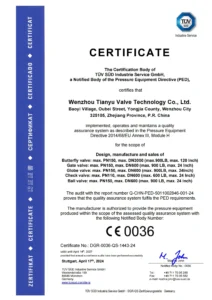
TIANYU-VALVE ISO certificate of conformity
Requirements Imposed by These Standards
- Design: Standards dictate the structural integrity and materials used in check valves. They specify the types of check valves (swing, lift, tilting disc, etc.) and their suitability for different pressure and temperature conditions.
- Manufacturing: The manufacturing process must adhere to strict quality control measures outlined in these standards. This includes tolerances, material specifications, and the use of appropriate manufacturing techniques to ensure durability and reliability.
- Testing: Check valves must undergo rigorous testing to meet the performance criteria set by the standards. This includes pressure testing, flow testing, and backflow prevention testing to ensure they function correctly under various operating conditions.
- Safety and Reliability: Standards emphasize the importance of safety features and the valve’s ability to prevent backflow, which is crucial in preventing system damage and ensuring process integrity.
- Compatibility: By adhering to these standards, manufacturers can ensure that their check valves are compatible with other components in the system, facilitating easy integration and maintenance.
- Global Trade: Compliance with international standards like ISO facilitates global trade by providing a common set of specifications that are recognized and accepted worldwide.
These standards serve as a blueprint for the development and production of check valves, ensuring that they meet the highest quality and safety benchmarks in the industry. They are interconnected, with each standard complementing the others to provide a comprehensive framework for check valve design and use.


